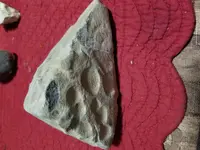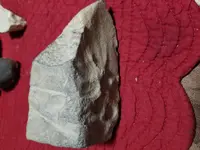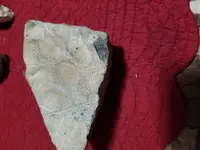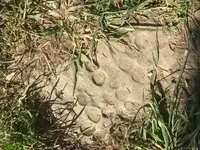You are using an out of date browser. It may not display this or other websites correctly.
You should upgrade or use an alternative browser.
You should upgrade or use an alternative browser.
Is this a Nutting Stone?
- Thread starter Jcharman
- Start date
IMAUDIGGER
Silver Member
- Joined
- Mar 16, 2016
- Messages
- 3,398
- Reaction score
- 5,195
- Golden Thread
- 0
- Primary Interest:
- All Treasure Hunting
What kind of rock is it?
How big is it?
How big is it?
dognose
Silver Member
It looks like a natural occurring anomaly to me. I dont see the marks or indications I would expect to see on it - from the images.
Even though it was found in a plowed field, when the material which would become this stone was formed or after, it could have had these circular depression cut into the stone some other way than a native american nutting stone.
Millions of years ago weathering and water movement could have caused a hard small pebble to bounce around in this depression, gradually making the depression larger.
Even though it was found in a plowed field, when the material which would become this stone was formed or after, it could have had these circular depression cut into the stone some other way than a native american nutting stone.
Millions of years ago weathering and water movement could have caused a hard small pebble to bounce around in this depression, gradually making the depression larger.
Peridot613!
Tenderfoot
Yes I think the one I found - still embedded in earth might be the same size. Also what I think was farmland but now a school yard.It is about 3.5"x5" and about 2.5" thick. I'm not sure what type of rock it is.
It couldn’t be a Nutting Stone?
Attachments
Looks natural water erosion.View attachment 1867765View attachment 1867766View attachment 1867767
I found this while walking a plowed field in central North Carolina. Can anyone tell if it's a Nutting Stone or just a natural rock? Thanks!
Tdog
Silver Member
- Joined
- May 30, 2019
- Messages
- 2,863
- Reaction score
- 5,264
- Golden Thread
- 0
- Location
- East Central Alabama
- Primary Interest:
- Relic Hunting
Doesn't even resemble a typical nutting stone. What makes you think it's a nutting stone?
Peridot613!
Tenderfoot
What is a “typical “ nutting Stone? After reading an article by Jim Maus on Nutting Stones and viewing numerous photos I’m simply finding similarities. The fact that it is located adjacent to a large hardwood forest is also a factor.Doesn't even resemble a typical nutting stone. What makes you think it's a nutting stone?
Tdog
Silver Member
- Joined
- May 30, 2019
- Messages
- 2,863
- Reaction score
- 5,264
- Golden Thread
- 0
- Location
- East Central Alabama
- Primary Interest:
- Relic Hunting
What is a “typical “ nutting Stone?
See post #6 in this link...
Couple more nutting stones!
I went creek hunting Wednesday & found a couple more nutting stones! The red one is really cool has multiple cups on both sides!
Missouri Breaks
Full Member
Not that we want to place stock in wether an object feels good in the hand when determining if an ambiguous rock is actually an ancient tool, it’s a legitimate factor on a list of factors in ID’ing something. Something as vigorous as the food processing tools always had to protect the fingers and reduce fatigue, something the ancient people learned from experience. Perhaps figuring out how it might’ve been held could be helpful. Your piece seems to have similar depressions albeit at varying depths on multiple surfaces, this is something that would need to be explained along the lines of the intention the maker had.
Similar threads
- Replies
- 15
- Views
- 913
- Replies
- 6
- Views
- 887
- Replies
- 3
- Views
- 572
Users who are viewing this thread
Total: 1 (members: 0, guests: 1)







